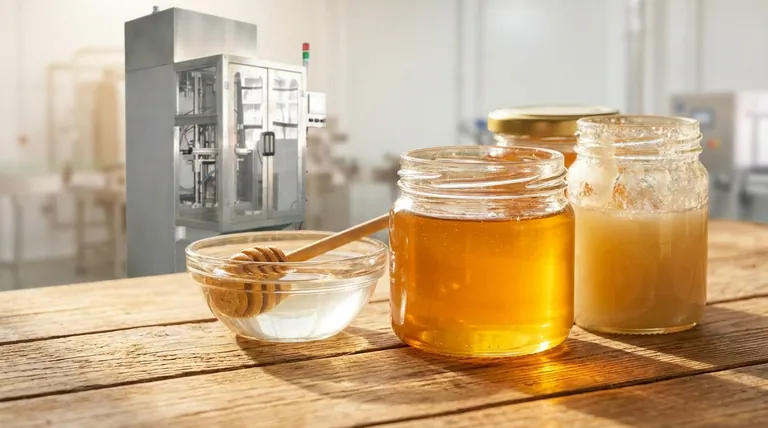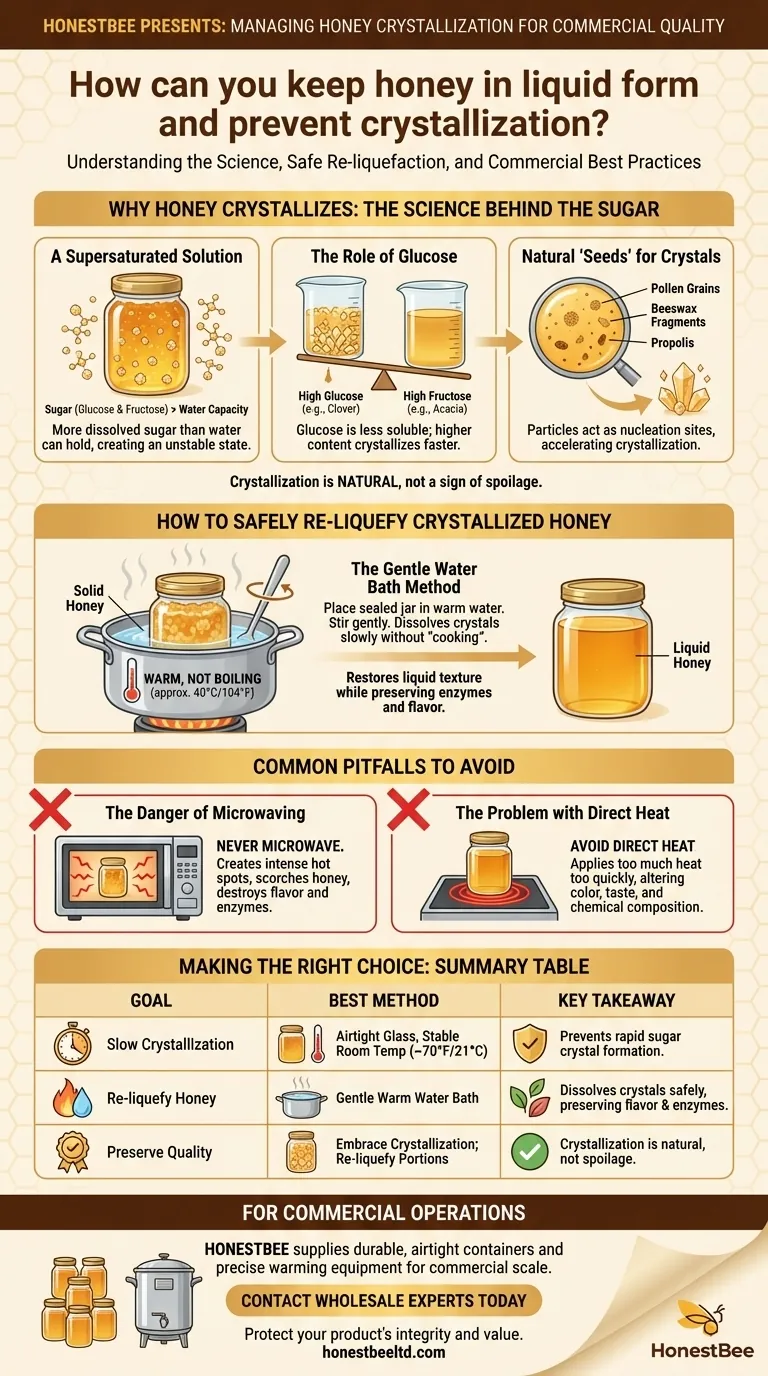To keep honey in its liquid form, you should store it in an airtight container in a cool, dry place at a stable room temperature, away from direct sunlight. Preventing crystallization entirely is difficult as it's a natural process, but proper storage can significantly slow it down. If your honey does crystallize, you can easily return it to a liquid state by gently warming the jar in a warm water bath.
Crystallization is not a sign of spoilage or poor quality—it is the natural behavior of pure, raw honey. The key is not to fight this process aggressively but to understand how to manage it gently with low, indirect heat.

Why Honey Crystallizes: The Science Behind the Sugar
Understanding the cause of crystallization is the first step toward managing it effectively. It's a process rooted in the fundamental chemistry of honey.
A Supersaturated Solution
Honey is a supersaturated solution, meaning it contains more dissolved sugar—primarily glucose and fructose—than water can naturally hold. This creates an unstable state where the sugar is always looking for a reason to return to its solid, crystalline form.
The Role of Glucose
The ratio of glucose to fructose in honey is the primary factor determining how quickly it crystallizes. Glucose is less soluble in water than fructose, so it crystallizes much more easily. Honeys with a higher glucose content (like clover or dandelion honey) will crystallize rapidly, while those with higher fructose content (like acacia or tupelo honey) can remain liquid for years.
Natural "Seeds" for Crystals
Raw, unfiltered honey contains tiny particles like pollen grains, beeswax fragments, and propolis. These particles act as nucleation sites, giving the glucose crystals a starting point to form and grow, which accelerates crystallization.
How to Safely Re-liquefy Crystallized Honey
If your honey has solidified, reversing the process is simple and safe, provided you avoid excessive heat that can damage its delicate flavor and beneficial enzymes.
The Gentle Water Bath Method
This is the most reliable and recommended technique. Place your sealed glass jar of honey in a pot of warm—not boiling—water. Let it sit, gently stirring the honey occasionally as the crystals dissolve. This provides slow, even heat that preserves the honey's quality.
Why It Works
Gentle, indirect heat provides enough energy to dissolve the glucose crystals back into the solution without "cooking" the honey. This restores its liquid texture while keeping its aromatic compounds and natural enzymes intact.
Common Pitfalls to Avoid
How you handle honey is just as important as where you store it. Certain common practices can inadvertently harm its quality.
The Danger of Microwaving
Never use a microwave to re-liquefy honey. Microwaves create intense, uneven hot spots that can easily scorch the honey, caramelizing the sugars and destroying its delicate flavor. This rapid overheating also degrades the beneficial enzymes and antioxidants.
The Problem with Direct Heat
Placing your honey jar directly in a boiling pot or on a stovetop is also a mistake. Like microwaving, this applies too much heat too quickly, which will alter the honey's color, taste, and chemical composition for the worse.
Don't Confuse Crystallization with Spoilage
It is critical to understand that crystallized honey has not gone bad. It is perfectly safe and edible. In fact, for many raw and unprocessed honeys, crystallization is a mark of authenticity, proving it hasn't been overheated or heavily filtered.
Making the Right Choice for Your Goal
Your approach to managing honey depends on your priorities.
- If your primary focus is slowing crystallization: Store honey in an airtight, glass container at a stable room temperature (around 70°F or 21°C).
- If your primary focus is fixing crystallized honey: Use a gentle, warm water bath to slowly dissolve the crystals without damaging the honey's quality.
- If your primary focus is preserving maximum quality: Embrace crystallization as a natural sign and only re-liquefy small portions as needed, leaving the rest of the jar solid.
By understanding honey's natural tendencies, you can ensure you always enjoy it in its best possible state.
Summary Table:
| Goal | Best Method | Key Takeaway |
|---|---|---|
| Slow Crystallization | Store in airtight glass at stable room temp (~70°F/21°C) | Prevents rapid sugar crystal formation. |
| Re-liquefy Honey | Gentle warm water bath | Dissolves crystals safely, preserving flavor and enzymes. |
| Preserve Quality | Embrace crystallization; re-liquefy small portions as needed | Crystallization is natural and not a sign of spoilage. |
For commercial apiaries and distributors, honey quality is your business.
Proper storage and handling are essential for maintaining the premium quality of your honey harvest. HONESTBEE supplies the durable, airtight containers and precise warming equipment that commercial operations need to manage crystallization effectively at scale.
Let us help you protect your product's integrity and value. Contact our wholesale experts today to discuss your beekeeping supply needs.
Visual Guide

Related Products
- Fully Automatic Honey Filling Packaging Machine for Processing Line
- Pneumatic Double Nozzle Honey Filling Bottling Packaging Machine
- Double Nozzle Small Honey Filling Machine Honey Sachet Packing Packaging Equipment
- Semi Automatic Small Honey Bottle Filling Machine Honey Filler
- Manual Honey Filling Machine Bottling Machine for Honey
People Also Ask
- What are the different types of honey fillers? A Guide to Manual, Semi & Fully-Automatic Fillers
- What are the types of bottling machines used for honey? Find the Right Filler for Your Scale
- How does automation in honey filling reduce labor costs? Boost Efficiency & Cut Costs by 30%
- What are the key features of a honey packaging machine? Essential for Quality & Efficiency
- What are the benefits of using honey filling machines? Boost Efficiency & Quality in Your Apiary



















